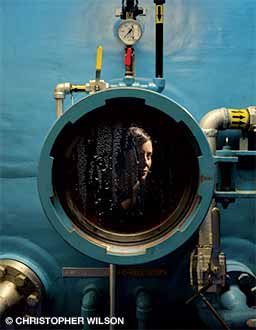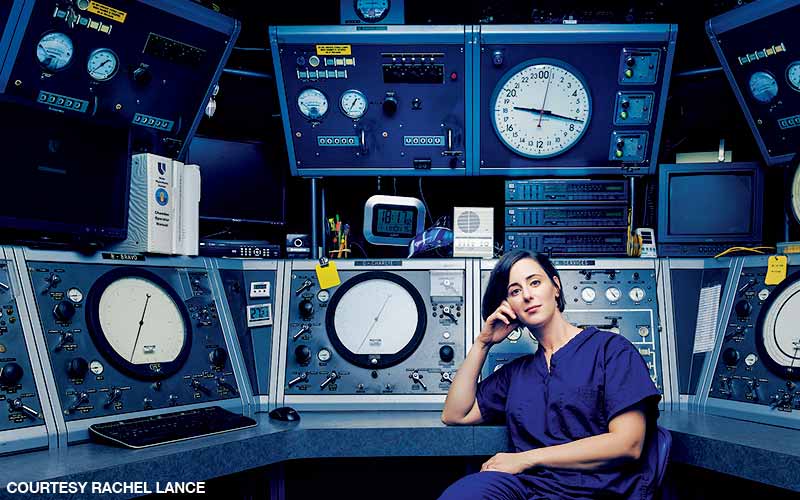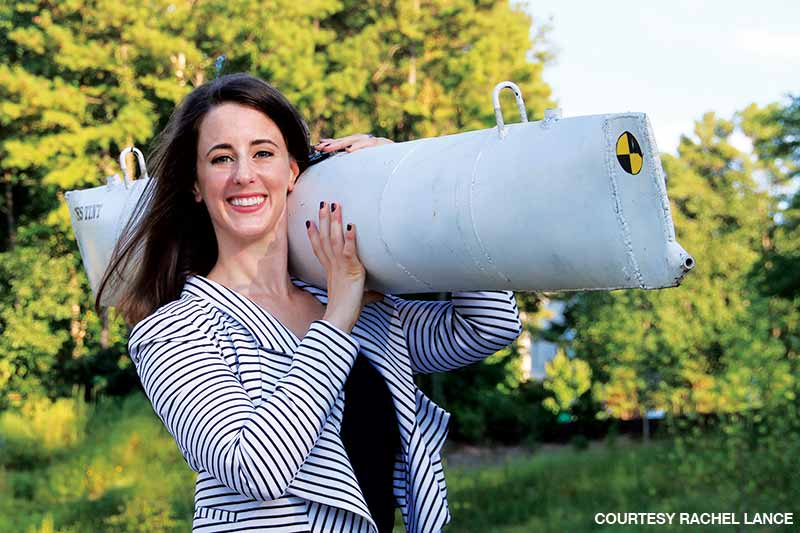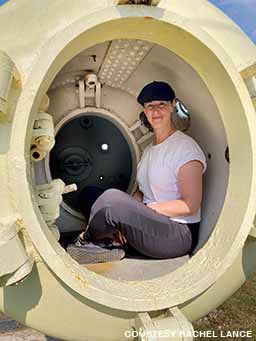Rachel Lance s'intéresse aux environnements extrêmes et à l'amélioration de la communication scientifique.
Rachel Lance, Ph.D., is an assistant consulting professor at the Duke Center for Hyperbaric Medicine and Environmental Physiology and an author with Penguin Random House. She holds a bachelor’s and master’s degree in biomedical engineering from the University of Michigan and a Ph.D. in the same field from Duke University. Her initial work focused on the fluid mechanics of breathing and got her a job as a mechanical engineer with the U.S. Navy. When she came to Duke for her doctoral work, she began focusing on extreme environments, particularly the effects of explosions.

“Once I crawled inside the Duke hyperbaric chambers,” Lance said, “I fell in love and refused to leave.” She currently splits her time between work as a research professor and authoring nonfiction books about science.
Qu'est-ce qui a suscité votre intérêt pour la plongée et la physiologie hyperbare ?
The human body is fascinating, especially when it fails. We are not naturally equipped to survive in a deep underwater environment, so I am fascinated with the idea of finding ways to do so anyway. Perhaps it’s my naturally rebellious side.
Qu'est-ce qui vous a intéressé en premier lieu, la plongée ou la science de la plongée ?
Sans aucun doute la plongée. J'ai commencé à plonger en Californie du Sud, dans le parc de plongée de l'île de Catalina, et je pense que j'étais la seule personne de ma classe à aimer calculer les tables de plongée. J'ai adoré la façon dont nous pouvions appliquer les mathématiques et la physiologie pour assurer notre sécurité dans un environnement qui aurait pu être incroyablement hostile. Ensuite, j'ai commencé à travailler bénévolement à la chambre hyperbare de Catalina de l'université de Californie du Sud, où je pillais régulièrement la bibliothèque du site pour y trouver des manuels sur la science de la plongée et les lire sur une falaise surplombant l'océan. À partir de là, je me suis donné pour mission de faire de la science de la plongée une carrière.
Comment avez-vous commencé à plonger ?
Lorsque j'étais en deuxième année, mon professeur nous a donné des photocopies de John Goddard’s Life List. At a young age Goddard had listed all the things he wanted to accomplish during his life, which eventually encouraged him to become an adventurer. The assignment was for us to make our own list, but my eyes were laser-focused on one particular item on Goddard’s list: dive the Great Barrier Reef. I was a scrawny, myopic 6-year-old from inland Michigan, and the water petrified my mother, but literally all I could think to add to my life list were places to dive. From there it became a matter of time until I could scrape together the money and opportunity to learn.
Quelle a été votre plongée la plus effrayante ?
My scariest dive happened when I was serving as a divemaster for an instructor friend. It was a beach dive off a jetty in Florida, and the water was murky, so even though the class was small and they weren’t going deep, he asked me to join and bring up the rear to keep the class together. I could barely see the fin tips of the student in front of me through the silt, but it quickly became apparent something terrible had happened to them.
I helped them surface quickly but safely, even though they were obviously in severe pain. It turned out some tourists had cast fishing lines over the class despite our prominent, visible dive buoy, and one of them had hooked the student, embedding the fishhook deep into their foot through their neoprene boot. I was thankful we hadn’t been deep when it happened, but I made sure to cut away the fisher’s bobber and weights as a small act of retaliation when I cut the student loose. The wound was bad enough that I had to tank-tow them back to shore for medical attention.
Quel est votre site de plongée préféré ?
J'adore les plates-formes pétrolières au large de la côte sud de la Californie. Ces plates-formes ont des pieds en forme d'échasses qui atteignent des centaines de pieds de profondeur, ce qui donne l'impression de plonger dans une cathédrale bleue profonde et sans fond, surmontée d'un plafond en vitrail au-dessus de vous, rempli de lions de mer qui gambadent. Les courants peuvent être assez violents, mais la beauté est incroyable.

Sur quoi avez-vous travaillé pour la marine américaine ?
J'ai travaillé au Naval Surface Warfare Center Panama City Division, sur la même base et juste en face du parking de l'unité de plongée expérimentale de la marine. Lorsque je travaillais à Panama City, en Floride, mes principaux projets concernaient les recycleurs. Je faisais partie de la branche qui concevait les équipements sous-marins, mais en tant que passionné de plongée, les projets relatifs aux recycleurs étaient mes préférés. J'ai travaillé comme ingénieur de projet pour convertir le recycleur Megalodon d'InnerSpace en un modèle de qualité militaire, que le personnel de la marine utilise aujourd'hui sous le nom d'UBA Mk28.
Que faites-vous à Duke ?
As assistant consulting professor at the Duke Center for Hyperbaric Medicine and Environmental Physiology, I research questions of survival in extreme environments, most often underwater. Since I am a biomedical engineer, I have a particular place in my heart for projects that develop and test new technology to better enable human survival underwater or allow measurement of what is happening with human physiology while we are underwater. Since hyperbarics and the deep ocean are unique environments, most common tools aren’t built for use in them, so our community has to engineer our own equipment to conduct medical research.
Quels sont les grands thèmes de la science de la plongée auxquels la communauté sera confrontée au cours des dix prochaines années ?
I’m interested to see what we do with oxygen toxicity, specifically being able to predict central nervous system oxygen toxicity. Oxygen toxicity is such a monster of mystery that we don’t have great guidelines for predicting it, except to tell people to stay below a certain threshold. We don’t even have clear markers for predicting an oxygen convulsion if someone is hooked up to an electroencephalogram when the convulsion happens.
I think a couple of interesting projects are happening right now that have the potential to pull a few threads out of this complex knot and maybe begin to unravel it just a bit. New projects aim at looking at what’s happening inside the brain during elevated oxygen exposures. A few researchers are collectively working at putting together some new, larger data sets that might provide more insight.

What’s up with that Civil War submarine?
Oh, tu parles de mon vieux copain, le H.L. Hunley? Les Hunley was a homemade — yes, homemade — submarine used by the Confederacy during the Civil War. It became famous as the first submarine ever to sink an enemy ship in combat when it sank the USS Housatonic on Feb. 17, 1864, but it disappeared after its victory. Even after it was recovered in 2000, the mystery of its disappearance only deepened when the crew’s remains were discovered inside with no signs of skeletal damage.
Le mystère de la Hunley started as a side interest and slowly snowballed until it consumed my life. It became part of my doctoral dissertation on underwater blast trauma, and I picked away at the story until I felt confident saying the underwater blast killed the crew. Because of my experience with dive science, I was able to evaluate the air supply inside the submarine’s hull and conclude that the crew likely didn’t die from running out of oxygen inside the enclosed space. That project was even more proof that a good base of dive knowledge will serve you well in unexpected places. I eventually turned that project’s story into a book when people kept asking me questions about the work, which is unusual when you’re a scientist.
Combien de temps vous a-t-il fallu pour écrire ce livre ?
Il a fallu environ un an pour écrire Dans les vagues, le livre sur la Hunley project. I had already compiled all the historical documents from working on the project during my doctoral dissertation, but I hadn’t researched the story’s human aspect. I wanted to make sure that I painted each character as a real, complete human being with nuance and complexity, and that took some legwork, given that they died more than 150 years ago.

You were recently out of the country to research another book. What’s the next one going to be about, and when can we expect to read it?
Le prochain livre est provisoirement intitulé Les plongeurs de la Chambre : Le travail secret d'un groupe d'hommes et de femmes francs-tireurs qui ont contribué à gagner la Seconde Guerre mondiale. As the name suggests, it’s about some hyperbaric chamber researchers. It is a nonfiction story of scientists who did some exciting and extremely dangerous experiments on themselves during the war. Almost everyone in the group had a serious injury during the testing, but what they learned about underwater survival ultimately enabled the scouting of the beaches of Normandy before D-Day, which informed the success of the landings. Their work was highly classified until 2001, which is why the story has never been public before. A highlight of the research was finding a handwritten note from Jacques Cousteau thanking the group for teaching him about underwater physiology.
Malheureusement, le calendrier a été retardé en raison de la pandémie qui m'a empêché d'effectuer les recherches sur place au Royaume-Uni, mais maintenant que j'ai tous les documents nécessaires, je travaille à plein régime. Je travaille avec la même formidable équipe littéraire que celle de Dans les vagues et j'espère que le livre sortira au début de l'année 2023.
Y a-t-il autre chose que vous aimeriez partager avec nos lecteurs ?
Dans mon enfance, j'ai toujours voulu être un scientifique ou un ingénieur et je ne me suis jamais considéré comme un écrivain. Maintenant que je suis scientifique, ingénieur et écrivain, je me rends compte à quel point ces mondes se recoupent. Tout ce qui touche à la science est plus facile lorsque vous pouvez communiquer clairement et succinctement les résultats de votre travail.
© Alert Diver — Q3/Q4 2021